DNR: Bat killing disease spreading in Minnesota, decimating colonies

Updated 5 p.m. | Posted 11:34 a.m.
White-nose syndrome, a disease that can be fatal to hibernating bats, is continuing to spread across Minnesota, killing the creatures and driving down the bat populations in the state's major bat caves, officials said Thursday.
White-nose has now been confirmed in six Minnesota counties. It was first found in St. Louis County last year but is now present in Becker, Dakota, Fillmore, Goodhue and Washington counties, the Minnesota Department of Natural Resources said in a statement.
Create a More Connected Minnesota
MPR News is your trusted resource for the news you need. With your support, MPR News brings accessible, courageous journalism and authentic conversation to everyone - free of paywalls and barriers. Your gift makes a difference.
It's also killing bats in the state at alarmingly high numbers.
Early last year, hundreds of dead bats were found in northeastern Minnesota at Soudan Underground Mine State Park, home to the state's largest population of hibernating bats.
That confirmed the presence of the bat-killing disease in Minnesota. This year the scene at the state park was even grimmer.
"We did a systematic count of dead bats that were found right around the headframe at Soudan, over about 12- to 14-day period, said Ed Quinn, natural resource program coordinator at the Minnesota DNR. "And we did come up with nearly 3,000 dead bats, just in that period."
The mine probably housed around 10,000 bats in 2013. Now that number has dropped by 73 percent, agency officials said.
A similar scene is beginning to play out in the southeastern corner of the state, where the disease has now been found in four counties.
In Fillmore County, the count at Brightsdale Tunnel was down 39 percent from last year, and the count at Bat River Cave decreased 31 percent.
DNR biologists think the sharp decline at Soudan is likely because the disease arrived there first, and suggested that bat deaths there and in other parts of the state are likely to rise.
"Keep in mind that to the east of us, they have had declines as high as 98 to 100 percent," said DNR mammologist Gerda Nordquist. "So we may possibly see that in some of our hibernating sites."
The disease is named for the fuzzy white growth of fungus observed on infected bats. The fungus was detected in 2013 at Soudan and at Forestville/Mystery Cave State Park in southeastern Minnesota.
It's typical for the disease to appear two to three years after the fungus.
It was first confirmed in North America in 2007 in eastern New York and has since spread to 30 states and five Canadian provinces, killing more than 5.7 million bats.
The good news, relatively speaking, is that in some places in the eastern U.S. the bat population crash seems to have leveled off.
"We are seeing some of what state biologists have referred to as the "bottoming out" of populations," explained Jonathan Reichard, national assistant coordinator for white-nose syndrome with the U.S. Fish and Wildlife Service. "Where they seem to be hitting a critical low, where declining numbers are no longer recorded."
But he cautioned it's still too early to tell whether bat populations are actually recovering.
Bats have very low reproductive rates. Researchers in Minnesota are working to identify habitat that bats use in the summer to raise their young. The hope is to develop better ways to manage the forest to help bats regrow their populations.
While white-nose syndrome is not known to pose a threat to humans, pets or livestock, it can decimate bat colonies.
That's a serious problem on many fronts. Bats are voracious bug eaters crucial to Minnesota's ecosystem.
"The commonly cited statement is that a healthy bat will eat its weight in insects every night," said DNR endangered species coordinator Rich Baker.
One study suggests the loss of bats in North America from white-nose syndrome could lead to agricultural losses from insects of $3.7 billion per year.
Conservation officials said they're weighing responses, including testing new fungicides that may kill white-nose spores. "Treatments are unlikely to eradicate WNS, but could slow the spread and reduce the number of bat deaths," the DNR acknowledged.
The agency also said state park visitors at Soudan and Mystery Cave can play a role in helping stop the disease's spread.
Visitors to the caves can "inadvertently carry fungal spores to other caves on clothing and caving gear."
Officials are also counting on the public's help in documenting the spread of the disease. They're asking people to report strange bat behavior, such as flying around during daylight hours.
Such citizen reports helped the DNR trace white-nose syndrome to four new counties this year. The fungus that causes the disease has been found in another four counties in the state, including Hennepin and Ramsey.